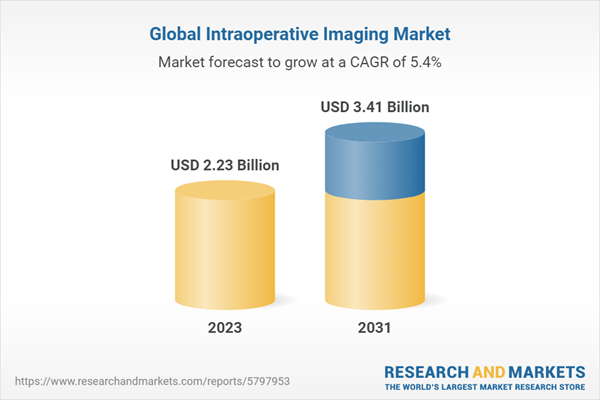Intraoperative Imaging Market: Introduction
Intraoperative imaging refers to the use of imaging technologies during surgical procedures to provide real-time visualization of anatomical structures, assist with navigation and guidance, and help surgeons make informed decisions. This technology allows surgeons to view high-resolution images of the patient's anatomy in real-time during the operation.There are several types of intraoperative imaging techniques, including:
- X-ray-based imaging such as fluoroscopy and digital radiography
- Ultrasound Imaging
- Magnetic Resonance Imaging (MRI)
- Computed tomography (CT) Scanning
- Improved surgical accuracy: Intraoperative imaging allows surgeons to visualize the exact location of anatomical structures and any abnormalities, which can help them perform procedures with greater precision
- Reduced risk of complications: Intraoperative imaging can help surgeons avoid damaging critical structures such as nerves and blood vessels, reducing the risk of complications during and after surgery
- Real-time feedback: With real-time imaging, surgeons can see the effects of their interventions immediately, allowing them to make adjustments as needed
- Enhanced patient outcomes: Intraoperative imaging can help reduce the risk of complications and improve the success rate of surgical procedures, leading to better patient outcomes
Intraoperative Imaging Market Segmentations
The market can be categorised into product, application, end user, and major region.Market Breakup by Product
- CT Scanners
- MRI Scanners
- Ultrasound Systems
- C-arm System
- X-Ray System
- Optical Imaging System
Market Breakup by Application
- Neurosurgery
- Orthopaedic Surgery
- ENT Surgery
- Oncology Surgery
- Trauma Surgery/ Emergency Room
- Cardiovascular Surgery
- General Surgery
- Other
Market Breakup by End User
- Hospitals and Diagnostic Centres
- Ambulatory Surgical Centres and Clinics
- Research Laboratories and Academic Institute
- Others
Intraoperative Imaging Market Breakup by Region
North America
- United States of America
- Canada
Europe
- United Kingdom
- Germany
- France
- Italy
- Others
Asia Pacific
- China
- Japan
- India
- ASEAN
- Australia
- Others
Latin America
- Brazil
- Argentina
- Mexico
- Others
Middle East and Africa
- Saudi Arabia
- United Arab Emirates
- Nigeria
- South Africa
- Others
Intraoperative Imaging Market Scenario
The intraoperative imaging market is witnessing a period of steady growth due to advancements in medical technology and an increasing demand for minimally invasive surgeries. Intraoperative imaging devices provide real-time visualization of the surgical area, enabling precise and safe surgical procedures. The global intraoperative imaging market scenario can be analysed based on key factors such as device types, applications, end-users, and regional markets.In terms of device types, the market is segmented into intraoperative computed tomography (CT), intraoperative magnetic resonance imaging (MRI), and intraoperative ultrasound. Among these, intraoperative MRI is expected to maintain its leading position in the market, owing to its superior soft tissue contrast and real-time imaging capabilities. Intraoperative ultrasound and CT are also experiencing considerable growth, as they offer benefits such as real-time guidance, reduced radiation exposure, and cost-effectiveness.
When it comes to applications, the intraoperative imaging market is divided into neurosurgery, orthopaedic surgery, cardiovascular surgery, and other surgical procedures. Neurosurgery holds a significant share in the market, as intraoperative imaging has proved invaluable in guiding complex neurosurgical procedures. Orthopaedic and cardiovascular surgeries are also driving growth in this market due to the increased demand for precision and minimal invasiveness in these procedures.
End-users in the intraoperative imaging market include hospitals, ambulatory surgical centres, and research institutions. Hospitals continue to dominate the market share, driven by the increasing adoption of advanced imaging technologies and growing patient volumes. Ambulatory surgical centres, however, are expected to witness a higher growth rate due to their focus on providing cost-effective and efficient surgical solutions.
Geographically, the intraoperative imaging market can be categorized into North America, Europe, Asia Pacific, Latin America, and the Middle East and Africa. North America holds the largest market share, primarily due to the presence of leading market players, advanced healthcare infrastructure, and increased adoption of cutting-edge technologies. Europe follows closely behind, with growth driven by the increasing prevalence of chronic diseases and a growing geriatric population. The Asia Pacific region is anticipated to experience the fastest growth in the coming years, as a result of improving healthcare infrastructure, increasing patient awareness, and expanding medical tourism.
Key Players in the Global Intraoperative Imaging Market
The report gives an in-depth analysis of the key players involved in the intraoperative imaging market. The companies included in the market are as follows:- Brainlab AG
- Medtronic plc
- NeuroLogica Corp
- Siemens Healthineers AG
- Koninklijke Philips N.V
- GE Healthcare
- Ziehm Imaging GmbH
- IMRIS
- Shimadzu Corporation
Table of Contents
Companies Mentioned
- Brainlab AG
- Medtronic plc
- Neurologica Corp.
- Siemens Healthineers AG
- Koninklijke Philips N.V.
- Ge Healthcare
- Ziehm Imaging GmbH
- Imris
- Shimadzu Corporation
Table Information
| Report Attribute | Details |
|---|---|
| No. of Pages | 147 |
| Published | May 2023 |
| Forecast Period | 2023 - 2031 |
| Estimated Market Value ( USD | $ 2.23 Billion |
| Forecasted Market Value ( USD | $ 3.41 Billion |
| Compound Annual Growth Rate | 5.4% |
| Regions Covered | Global |
| No. of Companies Mentioned | 9 |









